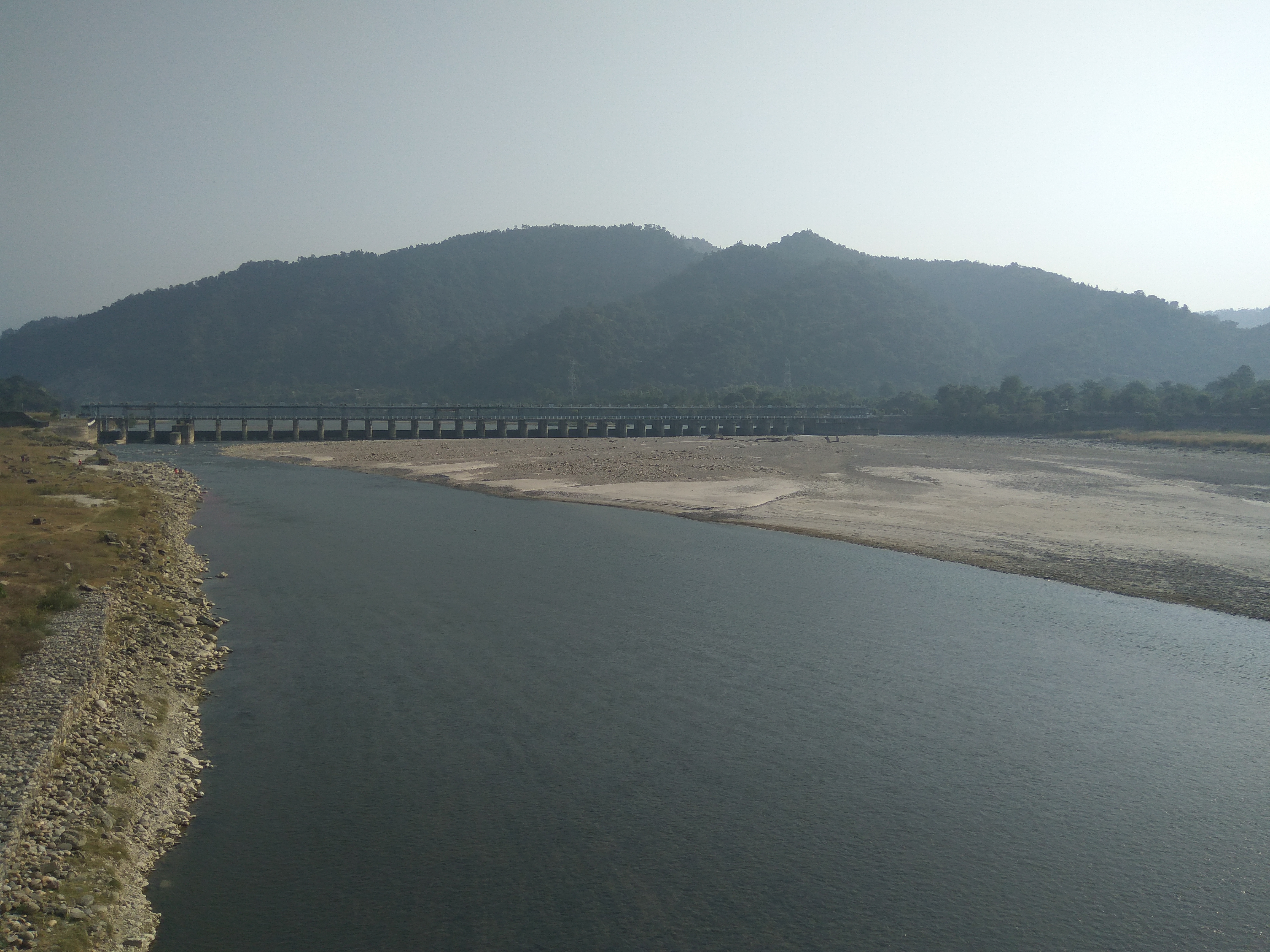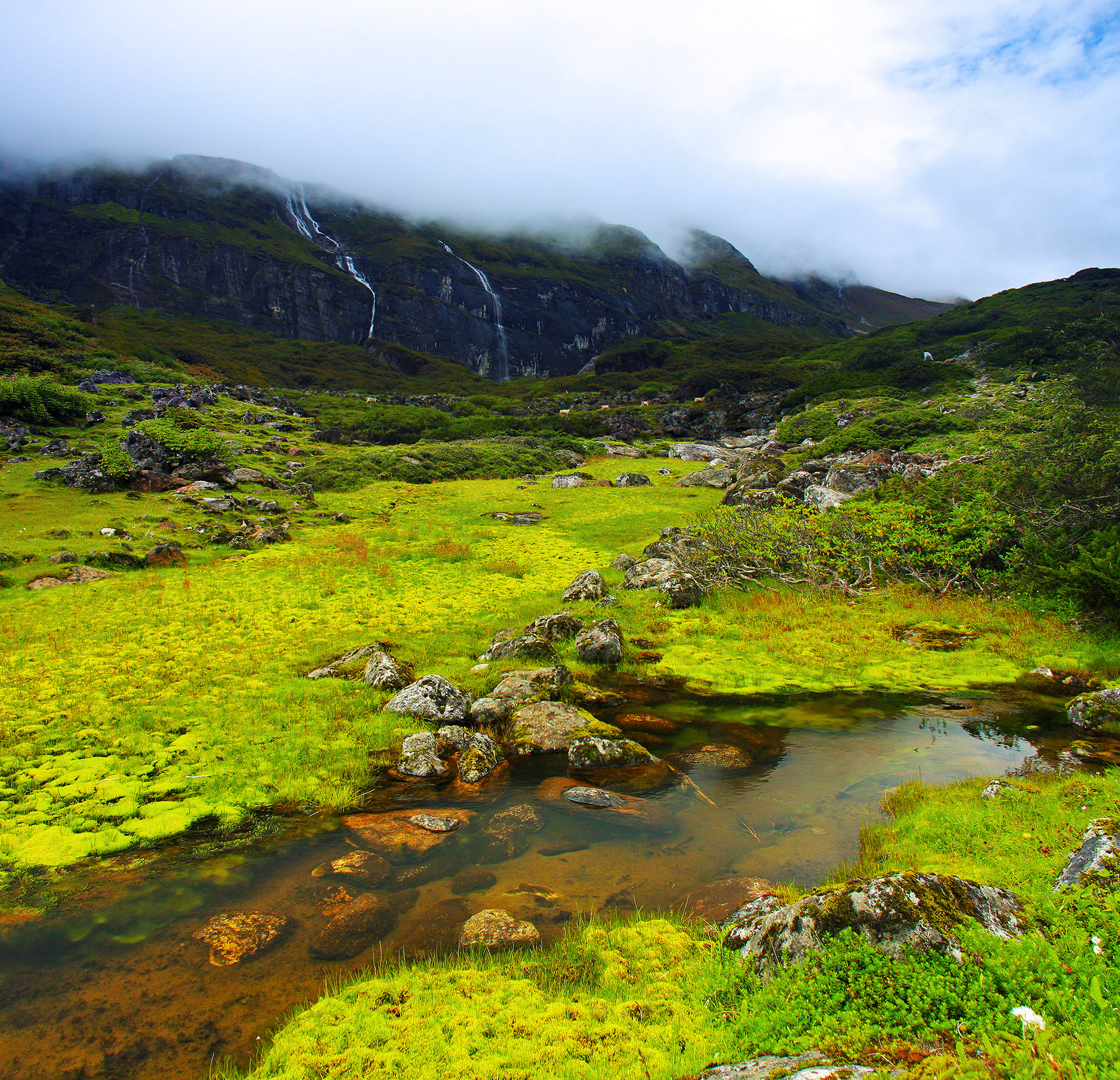|
Bagmati River
The Bagmati River flows through the Kathmandu valley of Nepal, separating the cities of Kathmandu and Patan, before flowing through Madesh Province of southern Nepal and joining the Kamla River in the Indian state of Bihar. It is considered holy by both Hindus and Buddhists. A number of Hindu temples are located on its banks. The importance of the Bagmati also lies in the fact that Hindus are cremated on the banks of this holy river, and Kirants are buried in the hills by its side. According to the Nepalese Hindu tradition, the dead body must be dipped three times into the Bagmati before cremation, so that the reincarnation cycle may be ended. The chief mourner (usually the first son) who lights the funeral pyre must take a holy river-water bath immediately after cremation. Many relatives who join the funeral procession also take a bath in the river or sprinkle holy water on their bodies at the end of the cremation. It is believed that the Bagmati River purifies people spir ... [...More Info...] [...Related Items...] OR: [Wikipedia] [Google] [Baidu] |
Pashupatinath Temple
Shri Pashupatinātha Temple () is a revered Hindu temple dedicated to Pashupati, a manifestation of the god Śiva. Located on the banks of the sacred Bagmati River in Kathmandu, Nepal, the temple is one of the oldest and most significant religious complexes in South Asia. Recognised as a UNESCO World Heritage Site since 1979, it forms part of the "Kathmandu Valley" inscription and is described as an "extensive Hindu temple precinct" comprising a vast network of temples, ''āśramas'', inscriptions, and images accumulated over centuries. Covering an area of 246 hectares, the complex includes over 500 subsidiary shrines surrounding the principal pagoda-style temple. Pashupatinātha is venerated as one of the holiest abodes of Śiva, praised in scriptures like the ''Skanda Purāṇa'' and honoured as a ''Paadal Petra Sthalam'' in the Tamil Tevaram hymns. The temple's Lingam, liṅga is believed, per the ''Śiva Purāṇa'', to be a wish-fulfilling embodiment of Śiva’s power. Myth ... [...More Info...] [...Related Items...] OR: [Wikipedia] [Google] [Baidu] |
Hindu Temple
A Hindu temple, also known as Mandir, Devasthanam, Pura, or Kovil, is a sacred place where Hindus worship and show their devotion to Hindu deities, deities through worship, sacrifice, and prayers. It is considered the house of the god to whom it is dedicated.; Quote: "The Hindu temple is designed to bring about contact between man and the gods of Hinduism religion" (...) "The architecture of the Hindu temple symbolically represents this quest by setting out to dissolve or decrease the boundaries between man and the divine". Hindu temple architecture, which makes extensive use of squares and circles, has its roots in later Vedic traditions, which also influence the temples' construction and symbolism. Through astronomical numbers and particular alignments connected to the temple's location and the relationship between the deity and the worshipper, the temple's design also illustrates the idea of recursion and the Microcosm–macrocosm analogy, equivalency of the macrocosm and t ... [...More Info...] [...Related Items...] OR: [Wikipedia] [Google] [Baidu] |
Tibet
Tibet (; ''Böd''; ), or Greater Tibet, is a region in the western part of East Asia, covering much of the Tibetan Plateau and spanning about . It is the homeland of the Tibetan people. Also resident on the plateau are other ethnic groups such as Mongols, Monpa people, Monpa, Tamang people, Tamang, Qiang people, Qiang, Sherpa people, Sherpa, Lhoba people, Lhoba, and since the 20th century Han Chinese and Hui people, Hui. Tibet is the highest region on Earth, with an average elevation of . Located in the Himalayas, the highest elevation in Tibet is Mount Everest, Earth's highest mountain, rising above sea level. The Tibetan Empire emerged in the 7th century. At its height in the 9th century, the Tibetan Empire extended far beyond the Tibetan Plateau, from the Tarim Basin and Pamirs in the west, to Yunnan and Bengal in the southeast. It then divided into a variety of territories. The bulk of western and central Tibet (Ü-Tsang) was often at least nominally unified under a ser ... [...More Info...] [...Related Items...] OR: [Wikipedia] [Google] [Baidu] |
Arun River (China–Nepal)
The Arun River () is a trans-boundary river that is part of the Koshi or Sapta Koshi river system in Nepal. It originates in the Tibet Autonomous Region of the People's Republic of China where it is called the Phung Chu or Bum-chu. Name In Tibet, the river is called ''Bum-chu'', also transliterated ''Phung-Chu'' or from Chinese as ''Peng Qu'' or ''Pumqu''. The ''Men Qu'' or ''Moinqu'' is an upper tributary draining glaciers from Shishapangma. In Nepal, the river's name changes to ''Arun''. Tibet The Tibetan name ''Bum-chu'' may refer to a religious ceremony attempting to divine prospects for the coming year from the level of water in a pot or well, ''chu'' is the Tibetan word for water. The river originates near Gutso in Nyalam County of Tibet. Around downstream, the Men-chu joins it. The Tingri county occupies the upper reaches of the Bum-chu and the lateral valleys formed by its tributaries, the foremost of which are Lolo-chu, Shel-chu, Rongpu-chu, Trakar-chu, Kharda-chu, ... [...More Info...] [...Related Items...] OR: [Wikipedia] [Google] [Baidu] |
Kosi River
The Kosi or Koshi is a transboundary river which flows through China, Nepal and India. It drains the northern slopes of the Himalayas in Tibet and the southern slopes in Nepal. From a major confluence of tributaries north of the Chatra Gorge onwards, the Kosi River is also known as the Saptakoshi (, ) for its seven upper tributaries. These include the Tamur River originating from the Kanchenjunga area in the east and Arun River and the Sun Kosi from Tibet. The Sun Koshi's tributaries from east to west are the Dudh Koshi, Likhu Khola, Tamakoshi River, Bhote Koshi and Indravati. The Saptakoshi crosses into northern Bihar, India where it branches into distributaries before joining the Ganges near Kursela in Katihar district. The Kosi is the third-largest tributary of the Ganges by water discharge after the Ghaghara and the Yamuna. The Kosi is long and drains an area of about in Tibet, Nepal and Bihar.Nayak, J. (1996). ''Sediment management of the Kosi River basin in ... [...More Info...] [...Related Items...] OR: [Wikipedia] [Google] [Baidu] |
Gandaki River
The Gandaki River, also known as the Narayani and Gandak, is one of the major rivers in Nepal and a left-bank tributary of the Ganges in India. Its total catchment area is , most of it in Nepal. In the Nepal Himalayas, the Gandaki is notable for its deep canyon. The basin also contains three mountains over , namely Dhaulagiri, Manaslu and Annapurna Massif. Dhaulagiri is the highest point of the Gandaki basin. In its upper reaches, the river is known as Kali Gandaki (or Gandaki) as it flows through the Mustang District and the famous Kali Gandaki Gorge in Nepal. When the river reaches the Terai plains of Nepal, it is referred to as the Narayani River. This name change typically occurs near the confluence with the Trishuli River at Devghat in Chitwan. Upon entering India, the river is known as the Gandak River. River course Nepal The Kali Gandaki river source is at the border with Tibet at an elevation of at the Nhubine Himal Glacier in the Mustang region of Nepal. T ... [...More Info...] [...Related Items...] OR: [Wikipedia] [Google] [Baidu] |
Bagmati River Irrigation Diversion
The Bagmati River flows through the Kathmandu valley of Nepal, separating the cities of Kathmandu and Patan, before flowing through Madesh Province of southern Nepal and joining the Kamla River in the Indian state of Bihar. It is considered holy by both Hindus and Buddhists. A number of Hindu temples are located on its banks. The importance of the Bagmati also lies in the fact that Hindus are cremated on the banks of this holy river, and Kirants are buried in the hills by its side. According to the Nepalese Hindu tradition, the dead body must be dipped three times into the Bagmati before cremation, so that the reincarnation cycle may be ended. The chief mourner (usually the first son) who lights the funeral pyre must take a holy river-water bath immediately after cremation. Many relatives who join the funeral procession also take a bath in the river or sprinkle holy water on their bodies at the end of the cremation. It is believed that the Bagmati River purifies people spiri ... [...More Info...] [...Related Items...] OR: [Wikipedia] [Google] [Baidu] |
Bagmati River, 1950 - 1955
The Bagmati River flows through the Kathmandu valley of Nepal, separating the cities of Kathmandu and Patan, before flowing through Madesh Province of southern Nepal and joining the Kamla River in the Indian state of Bihar. It is considered holy by both Hindus and Buddhists. A number of Hindu temples are located on its banks. The importance of the Bagmati also lies in the fact that Hindus are cremated on the banks of this holy river, and Kirants are buried in the hills by its side. According to the Nepalese Hindu tradition, the dead body must be dipped three times into the Bagmati before cremation, so that the reincarnation cycle may be ended. The chief mourner (usually the first son) who lights the funeral pyre must take a holy river-water bath immediately after cremation. Many relatives who join the funeral procession also take a bath in the river or sprinkle holy water on their bodies at the end of the cremation. It is believed that the Bagmati River purifies people spiri ... [...More Info...] [...Related Items...] OR: [Wikipedia] [Google] [Baidu] |
Gopal Raj Vamshavali
The Gopal Raj Vamshavali (IAST: Gopālarājavaṃśāvalī, Devanagari: गोपालराजवंशावली) is a 14th-century hand-written manuscript of Nepal which is primarily a genealogical record of Nepalese monarchs. One of the most important and popular chronicles in Nepalese history is by this name. This '' vamshavali'' was previously called ''Bendall Vaṃśāvalī'', as Prof. Cecil Bendall found the manuscript "in the cold weather of 1898–99 in Kathmandu's Durbar Library"Bendall (1903). Cited from Pant, Mahes Raj. (1993). On Reading ''The Gopālarājavaṃśāvalī''. ''Ādarśa''. upplement to ''Pūrṇimā'', the journal of ''Saṃśodhana Maṇḍala'' No. 1. Kathmandu: Pundit Publications. pp. 17–76. or the Bir Library. This was later, and popularly, called the ''Gopālarājavaṃśāvalī'' by scholars as Baburam Achayra and Yogi Naraharinath to name a few, as a hand-written catalog list of the library termed the manuscript ''Gopālavaṃśādi pr� ... [...More Info...] [...Related Items...] OR: [Wikipedia] [Google] [Baidu] |
Majjhima Nikāya
The ''Majjhima Nikāya'' ("Collection of Middle-length Discourses") is a Buddhist scripture collection, the second of the five Nikāyas, or collections, in the Sutta Piṭaka, which is one of the "three baskets" that compose the Pali Tipitaka (lit. "Three Baskets") of Theravada Buddhism. It was composed between 3rd century BCE and 2nd century CE. This nikaya consists of 152 discourses attributed to the Buddha and his chief disciples.A version of the Pali original is available in Overview Bhikkhu Bodhi in the introduction to his translation describes the collection as follows:If the Majjhima Nikāya were to be characterised by a single phrase to distinguish it from among the other books of the Pali Canon, this might be done by describing it as the collection that combines the richest variety of contextual settings with the deepest and most comprehensive assortment of teachings.The 152 discourses come in three parts each with five divisions. All divisions save the penultima ... [...More Info...] [...Related Items...] OR: [Wikipedia] [Google] [Baidu] |




